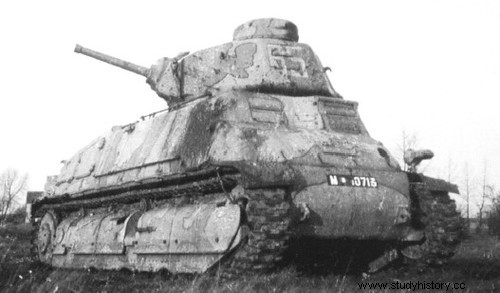Somua S 35

Type:medium tank
Country:France
Crew:3 men
Armament:a 47mm cannon, a coaxial 7.5mm mdle 31 machine gun
Shielding:max 56mm
Weight:20t
Dimensions:length 5.46m; width 2.108m; height 2.592m
Engine:Somua 8-cylinder water-cooled petrol
Power:190 hp at 2000 rpm
Performance:37km/h autonomy 257km
Service time from 1936 to 1940 in the French army used by the Germans
At the beginning of the 1930s, the French cavalry launched a call for tenders for an armored vehicle to be designated AMC (automitrailleuse de combat). A vehicle meeting the specifications was built by the SOMUA (Société d'Outillage Mécanique et d'Usinage d'Artillerie) of Saint-Ouen.
After the tests, the machine was accepted in the cavalry under the designation AMC SOMUA AC-3 Shortly after, the French army decided to adopt this type as a standard medium tank and redesignated it Char S-35, the "S" recalling the company name of the manufacturer and the number "35" the year of introduction.
Manufacturing had reached 500 units on Armistice Day. The 1st and 2nd Light Mechanical Divisions (DLM), both under the command of the 7th Army, and the 3rd DLM, under the authority of the 1st Army, each had 87 S35s. The 6th Light Cavalry Division (DLC) of Tunisia fielded 50 of them and some also served in the ile Armored Reserve Division (DCR). Tank for tank, the S-35 did better than defend itself against all the German machines of the time, but a bad tactical use gave it little chance of showing its value, except in a few isolated actions.
The S-35 had good armor, good mobility and good firepower; but its main fault - and traditional in French armored vehicles - lies in the fact that the tank commander was also a gunner and a provider. The hull consisted of three cast sections, i.e. the underbody, the front superstructure and the aft superstructure, assembled by bolting.
On the one hand the bolt joints ran just above the tracks and on the other hand the vertical joint between the two sections of the superstructure was near the rear of the turret.
In this mode of assembly resided one of the weaknesses of the tank because a direct blow on one of the joints was likely to literally split the machine in two. The maximum shell thickness was 41 mm. The driver sat at the front left, just in front of his personal hatch, most often left open when the tank was moving towards the front. The radio operator had his post to the right of the driver.
The normal route of entry for these two men was through a hatch in the left side of the hull; a manhole in the base offered a possibility of evacuation in case of emergency. The turret, also cast, with maximum shielding of 56 mm, was identical to that of the Char BI-bis and D2. The main armament consisted of a 47 mm SA 35 cannon, which pointed in elevation from +180 to -180 and in azimuth over 3600, the rotation of the turret being assisted by an electric motor.
The 47mm could fire either armour-piercing or high-impact ammunition, with maximum muzzle velocity reaching 670 m/sec.
A coaxial 7.5mm Model 31 was mounted to the right of the armament major. This weapon was remarkable for its field of fire limited to 100 on either side of the barrel.
The ammunition load was 118 rounds of 47 mm and 1,250 rounds of machine gun.
A slot was provided on the cupola of the tank ch€ for another 7.5 mm, this time for anti-aircraft defence.
This last weapon seems not to have been used in combat, the unfortunate tank commander already having too much on his plate!
The engine and transmission assembly were located aft of the hull, with the engine on the left and the "self-sealing" tank on the right. The engine compartment was separated from the combat chamber by a firewall The running gear grouped on each side two sets, each of four bogies mounted in pairs on articulated arms, which were served by semi-elliptical springs.
At the rear, the ninth bogie had its own spring. The tension wheel was at the front, the sprocket at the rear and there were two small support rollers. The lower part of the train received the protection of an armored cover that could be raised to give access to the sets of bogies.
The year 1940 saw the start of production of an improved model, the S-40. The engine went from 190 to 220 hp, the suspension was improved but few of these machines were ready before the signing of the armistice. in 1940. Another
interesting vehicle, [self-propelled SAu 40, was not to go beyond the prototype stage; it mounted a 75 mm under casemate to the right of the driver and carried a different turret.
The S-35 was also used by the Wehrmacht for training crews, police missions and even. in limited numbers. on the Eastern Front. The Germans gave this type of tank the designation of PzKpfw 35C 739 (f). Some were converted into command tanks and some were delivered to the Italian armies.
